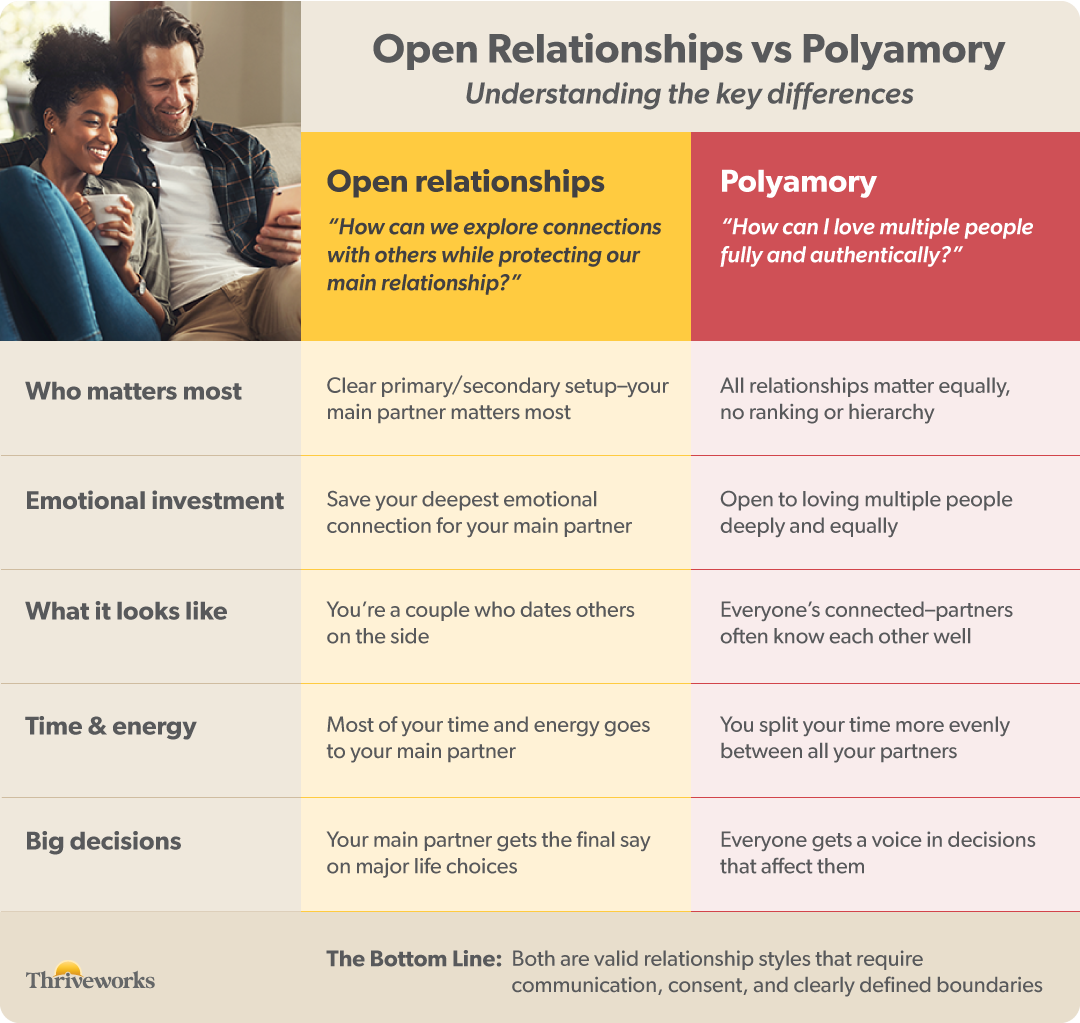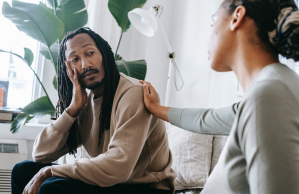If you’ve ever wondered whether your relationship could handle more openness—or if you’re already navigating the complex world of multiple partners—you’re not alone. More couples are exploring open relationships than ever before, yet many struggle with the fundamental question: What does it actually take to make this work?
While trust, openness, and communication matter in any relationship, open relationships demand these qualities in abundance. Without them, what starts as an exciting exploration can quickly become a source of pain and conflict.
An open relationship occurs when partners in a romantic relationship consensually agree that one or both may pursue additional sexual and/or romantic connections. But success isn’t just about getting permission; it’s about building the skills, boundaries, and emotional resilience to thrive in this relationship style.

What Is an Open Relationship? Definition and Types
An open relationship is a consensual romantic arrangement where all partners agree that one or more of them may pursue additional romantic or sexual relationships outside their primary partnership.
But here’s where it gets nuanced: “Open relationship” serves as an umbrella term that means vastly different things to different people. For some couples, it might mean occasional sexual encounters with clear emotional boundaries. For others, it could involve deep romantic connections with multiple partners. This is why relationship experts emphasize that clear communication about definitions and expectations isn’t just helpful, it’s essential.
The structure of open relationships varies widely. Some involve one partner exploring while the other remains monogamous. Others see both partners actively dating. Sometimes new partners connect with just one person in the original couple, while in other arrangements, everyone involved may develop interconnected relationships. The key distinction from infidelity? Everyone knows, everyone consents, and ideally, everyone feels respected in the process.
These relationships can range from purely physical connections to emotionally intimate bonds that rival the primary partnership in depth. The only constant is that all parties have agreed to this expanded relationship model, making consent and ongoing communication the foundation of everything that follows.
Open Relationships vs Polyamory: Key Differences Explained
While people often use these terms interchangeably, open relationships and polyamory have distinct differences that matter, especially when you’re trying to figure out which approach might work for you and your partner.
Here’s how they typically differ:
Polyamorous Relationships
These relationships center on the belief that you can genuinely love multiple people simultaneously, with each relationship holding equal emotional weight and significance. Polyamory isn’t just a relationship structure; it’s often considered a relationship orientation, meaning some people feel naturally inclined toward loving multiple partners deeply and authentically.
There are multiple types of polyamorous relationships, including:
- Triads: Three people each dating each other with the same level of commitment
- Vee: Two people (knowingly) dating the same person, but not dating each other
- Solo polyamory: Someone who is willing to be committed to someone but wants to live their own separate lives, dating others and not integrating their lives or “nesting” with their partner
- Polyfidelity: Maintaining a close relationship unit with an agreement not to sleep with or date other people outside those in the relationship
- And many more
In polyamorous arrangements, there’s typically a commitment to treating each partner with the same level of care, respect, and emotional investment. Many polyamorous networks involve interconnected relationships where partners know each other and may even share living spaces or close friendships.
Open Relationships
By contrast, open relationships almost always maintain a clear hierarchy with primary and secondary partners. The primary relationship remains the emotional and often practical center, while additional relationships serve different purposes—whether that’s sexual exploration, companionship, or lighter romantic connection. Partners in open relationships commonly agree to preserve their deepest emotional commitment for each other while allowing sexual or casual romantic experiences with others. This hierarchy means the primary partner typically receives the majority of time, emotional energy, and life-planning consideration, while secondary relationships have more defined boundaries around emotional involvement.
The key distinction? Polyamory asks “How can I love multiple people fully?” while open relationships ask “How can we explore connections with others while protecting our primary bond?”
Is an Open Relationship Healthy?
Yes, open relationships can be healthy when done right. However, like any relationship structure, keeping an open relationship healthy requires that all parties have active knowledge of and ongoing consent to each step of the process. Open relationships thrive when everyone involved fully understands both the potential risks and rewards.
“As long as the communication within the relationship is clear and partners are honestly communicating their wants and needs, open relationships can be and are a healthy thing,” says Alexandra Cromer, a licensed professional counselor at Thriveworks.
The key is that healthy open relationships demand extraordinary levels of vulnerability and self-accountability from everyone involved. Each person must take responsibility for speaking up when boundaries are crossed or when they’re being treated in ways they didn’t consent to—no one else can advocate for your needs.
What makes open relationships particularly challenging is that they’re constantly evolving. They’re “living arrangements” that shift as people grow, circumstances change, and new dynamics emerge. This means regular check-ins aren’t optional—they’re essential for monitoring what’s working, what isn’t, and whether everyone remains comfortable and satisfied with the arrangement.
Open Relationship Boundaries: Rules and Guidelines
Open relationship boundaries vary significantly between couples, as each partnership needs its own specific guidelines based on their unique comfort levels and relationship goals. Here are the most common boundary categories that couples establish:
1. Physical Intimacy Boundaries
Partners need to clearly communicate their comfort levels around sexual involvement with others. Some primary partners prefer that outside relationships remain strictly physical with no emotional connection, while others may want secondary relationships to be romantic but not sexual. These preferences often reflect what feels most threatening or acceptable to each person.
2. Emotional Connection Limits
Establishing clear boundaries around romantic and emotional involvement is crucial for many couples. Some individuals need secondary relationships to remain relatively free of deep emotional attachment, while others are more comfortable with emotional bonds than physical ones. These boundaries often evolve as relationships develop, making ongoing communication essential.
3. Health Protocols
Regardless of whether partners want to hear details about outside sexual encounters, safe sex practices must be established before any sexual interactions occur. This includes agreements about condom use, STD testing schedules, and sharing of sexual health information between all parties involved.
4. Time and Space Boundaries
It’s important to consider aspects like the amount of time spent with each partner, what spaces can or shouldn’t be shared, and what living arrangements will look like (e.g., will the primary partner spend the night at the secondary partner’s house, how often will they do so, will a secondary party stay with the primary couple, etc.). Not every couple might feel feel the need to discuss these limits since they might think their partner is on the same page, but an abundance of time spent with one partner over the other can quickly become grounds for resentment, so at least one conversation should definitely take place, and they should continue to do so as things evolve and change.
For boundaries to work effectively, both primary partners must fully, realistically, and readily consent to all established limits. Without complete agreement and active cooperation, conflict between the primary partners becomes almost inevitable.
The foundation of successful open relationship boundaries is mutual trust and respect. If a relationship lacks these essential elements from the start, introducing additional partners will likely amplify existing problems rather than enhance the partnership.
What NOT to Do in Open Relationships: Common Mistakes
Certain behaviors can quickly undermine even the most well-intentioned open relationship. Here are the most common relationship-damaging mistakes to avoid:
1. Breaking Established Boundaries
Violating previously discussed and agreed-upon limits doesn’t just hurt feelings, it can completely invalidate your partner’s sense of safety and consent. When boundaries are crossed, partners often feel betrayed and may withdraw their consent to continue the open arrangement entirely. This includes both obvious violations and seemingly minor boundary pushes that accumulate over time.
2. Communication Breakdowns and Dishonesty
Poor communication patterns like lying, hiding interactions, or failing to fully disclose your actions, thoughts, and feelings can create severe relationship distress. Even small omissions can snowball into major trust ruptures when your partner discovers what you’ve withheld. Transparency isn’t just preferred in open relationships—it’s essential for survival.
3. Using Passive-Aggressive Tactics
Passive aggression signals that frustrations are building beneath the surface without being addressed directly. When you avoid communicating concerns or express displeasure indirectly, these unresolved issues fester and create toxic dynamics. This behavior pattern leads both partners to become increasingly irritable and defensive, eroding the trust and empathy that open relationships require.
“Any type of passive or passive-aggressive communication, lying, hiding things, manipulation, deceit, and not being truthful about your personal wants and needs can destroy an open relationship,” Cromer says. “If any boundaries are crossed, that can also poison the dynamic.”
The stakes are high: When lies and deceit enter an open relationship, the complex dynamics can break down rapidly, often causing deeper hurt than traditional relationship conflicts because multiple people and relationships are affected simultaneously.
Do Open Relationships Last Longer?
No, open relationships do not necessarily last longer than monogamous relationships. A comprehensive 2025 study published in The Journal of Sex Research found that relationship satisfaction was similar in consensually non-monogamous (CNM) relationships when compared to monogamous relationships.
What determines relationship longevity isn’t the structure itself, but rather the foundational elements present in any lasting partnership: trust, reciprocity, and compromise. Most studies show that there is no significant difference between monogamy and consensual non-monogamy when it comes to longevity, commitment, separation and divorce.
Open relationships have the potential to be long-lasting when both partners actively engage in communication, respect established boundaries, and continuously discuss their evolving needs and preferences. The key difference is that these relationship skills become even more critical in non-monogamous arrangements due to their increased complexity.
Can You Cheat in an Open Relationship?
You can, but not typically. If all parties have genuinely consented to you engaging in romantic and/or sexual relationships with other people, it would not be considered “cheating” due to the consensual nature of the arrangement and the established understanding between everyone involved.
However, it is absolutely still possible to “cheat” in an open relationship, even when you have permission to engage in certain behaviors outside the primary relationship. Cheating in open relationships occurs when someone acts in ways that violate previously agreed-upon boundaries and consent agreements.
Common examples of cheating in open relationships include:
- Emotional boundary violations: If partners agreed that secondary relationships would remain purely physical, but one person develops deep emotional connections or falls in love with a secondary partner
- Communication breaches: Hiding interactions, lying about encounters, or failing to disclose agreed-upon information about outside relationships
- Safety protocol violations: Breaking established safe sex rules or sexual health agreements
- Boundary overstepping: Engaging in activities, locations, or relationship dynamics that were explicitly off-limits
This is precisely why clear communication and well-defined boundaries are absolutely vital for maintaining a healthy and trusting dynamic in an open relationship. Without transparent, ongoing dialogue about expectations and limits, there’s significant potential for inflicting emotional damage—whether knowingly or unknowingly—that can be just as devastating as traditional infidelity.
How to Make an Open Relationship Work: Expert Tips
Building a thriving open relationship requires intentional effort, clear communication, and ongoing commitment from everyone involved. Here are the essential strategies that relationship experts recommend:
1. Start with deep self-awareness.
“One of the most important things you can do is to make sure that you’ve taken time with yourself to identify your boundaries and personal wants and needs,” Cromer says. “Make sure that you are continuously in communication with your partner(s) and being receptive to their feedback. There should be a shared agreement on boundaries and preferences, and attempts to ensure the safety and comfort of all involved are critical.”
2. Consider professional guidance.
Attending couples counseling sessions can be extremely helpful if you’re considering an open relationship. Maintaining thorough and effective communication in non-monogamous arrangements is complicated and nuanced—without experience or guidance, it can be difficult to navigate successfully on your own. A supportive, trained mental health professional can guide each partner through the process of identifying personal preferences and boundaries while helping you explore ways to ensure emotional safety as you begin an open relationship.
3. Ensure genuine enthusiasm from all parties.
Without enthusiastic cooperation from everyone involved, open relationships inevitably lead to someone getting hurt. All partners must be genuinely excited about the arrangement, not just reluctantly agreeing to avoid conflict or abandonment.
4. Practice healthy compromise.
Being open and willing to find middle ground can be helpful, but true compromise does not mean changing your core values or preferences to fit your partner’s needs. Instead, it means collaboratively finding solutions that balance everyone’s preferences so that all parties feel satisfied and respected in the arrangement. If fundamental incompatibilities exist, it’s better to acknowledge them honestly than force an arrangement that compromises someone’s well-being.














